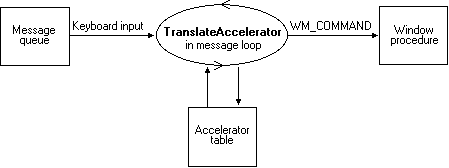
An accelerator table consists of an array of ACCEL structures, each defining an individual accelerator. Each ACCEL structure includes the following information:
To process accelerator keystrokes for a given thread, the developer must call the TranslateAccelerator function in the message loop associated with the thread's message queue. The TranslateAccelerator function monitors keyboard input to the message queue, checking for key combinations that match an entry in the accelerator table. When TranslateAccelerator finds a match, it translates the keyboard input (that is, the WM_KEYUP and WM_KEYDOWN messages) into a WM_COMMAND or WM_SYSCOMMAND message and then sends the message to the window procedure of the specified window. The following illustration shows how accelerators are processed.

The WM_COMMAND message includes the identifier of the accelerator that caused TranslateAccelerator to generate the message. The window procedure examines the identifier to determine the source of the message and then processes the message accordingly.
Accelerator tables exist at two different levels. The system maintains a single, system-wide accelerator table that applies to all applications. An application cannot modify the system accelerator table. For a description of the accelerators provided by the system accelerator table, see Accelerator Keystroke Assignments.
The system also maintains accelerator tables for each application. An application can define any number of accelerator tables for use with its own windows. A unique 32-bit handle (HACCEL) identifies each table. However, only one accelerator table can be active at a time for a given thread. The handle to the accelerator table passed to the TranslateAccelerator function determines which accelerator table is active for a thread. The active accelerator table can be changed at any time by passing a different accelerator-table handle to TranslateAccelerator.